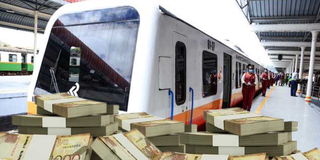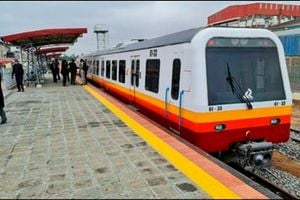
Ten of the 11 locomotives bought from Spain by the Kenyatta administration are lying idle.
Ten of the 11 diesel-powered locomotives that Kenya bought from Spain in a $15 million (about Sh2 billion) deal have stalled, raising questions on the poor state of the engines and wastage of public funds.
Staff at the Kenya Railways Corporation (KRC) yard say that most of them developed mechanical issues upon arrival three years ago. Kenya bought the Diesel Multiple Units (DMUs) from a Spanish firm, Serveis Ferroviaris de Mallorca (SFM), which were launched by then-President Uhuru Kenyatta in November 2020.
The deal faced opposition, with a section of senior management and engineers at KRC questioning the quality of the units and also the many years they had been in service, with some as old as 25 years. A check on the DMU schedule for this year shows only one, which serves Embakasi village with a ticket going for Sh50, is in service.
This will revive questions that were raised at the time of purchase, notably: Why did Kenya go for the ageing trains? Did taxpayers get value for their money? Did Kenya set up a repair yard before shipping in the locomotives?
“There are some that we have never used. We had not prepared a maintenance facility for them and so apart from the branding, we could not do much,” said the source who sought anonymity. Each of the DMUs cost between Sh71 million and Sh137 million, excluding spare parts.
The grounding of the DMUs came less than five years after a Sunday Nation exclusive story, which cited concerns by whistle-blowers at Kenya Railways Corporation (KRC), who warned against buying the refurbished engines given their age, condition and lack of spare parts.
The advice from experts appeared to have been ignored by both the Ministry of Transport and KRC management, who went ahead with the controversial deal that the Cabinet approved as one key solution to Nairobi’s urban transport challenges.
Refurbished DMUs
“Before the contract for the acquisition of the 11 refurbished DMUs is signed, every effort will be made to ensure there are no illegalities and that the interests of Kenyans are safeguarded. The government is committed to providing an efficient, safe and reliable commuter rail service,” KRC said then, after the Sunday Nation story on the planned purchase of the units.
Kenyatta also defended the units, saying they would boost the economy after the Sh6.6 billion renovation of rail lines and stations as well as the new ticketing system that was expected to eliminate fare evasion, which had dogged the previous commuter system.
The units, Kenyatta said, were to “complement the existing locomotives serving the Nairobi region, and were expected to drive the rise of commuter numbers to 132,000 after further expansion of tracks and addition of locomotives”.
KRC Managing Director Philip Mainga did not respond to queries from The Weekly Review over the matter. He did not respond to WhatsApp messages while the communications team at KRC also remained quiet.
The questions touched on KRC’s expertise or lack of it to repair the DMUs. We also sought to know if some of the units had been written off and whether KRC has a budget to fund the repairs. The Weekly Review sent questions to Mainga and the KRC communications team last month.
The DMUs were meant to serve Syokimau, Kitengela, Embakasi village, Kikuyu and Thika, where each was targeted to ferry 200 people.
At the time of purchase, consultants hired to review the viability of the deal had made recommendations for Kenya to drop the deal. DAR and GPO Group, hired to review the project, had said some of the units were in deplorable state and would require deep refurbishment to make them operational.
“Unit no.3 (61.19-62.04-61.20) is in quite bad condition and it would require a deep refurbishment process. Unit no. 12 (61.45-62.06-61.46) is the newest one and it is not confirmed that it is included in the package,” the consultants said.
Kenya also went against recommendations by the World Bank to upgrade the existing rail network, construct new stations and buy higher capacity trains.
The World Bank also wanted Kenya to first set up an operational Commuter Rail Unit before shipping in the units. The DMUs were also said to be slower, adding to the unanswered questions that KRC and the ministry avoided amid a rushed procurement process.
Kenya opted for the units under an ambitious plan to decongest the city by providing mass movement of people into and out of the CBD.
Acquisition of the DMUs was part of KRC’s Masterplan, which sought to increase capacity on commuter services in the capital from 13,000 to 132,000 passengers a day by 2022.
Successful roll-out of the DMUs would have greatly helped phase out dozens of public service vehicles (PSVs) from the city’s roads, besides helping lower pollution from fossil fuels. A team comprising top officials from the ministry, KRC and the World Bank recommended the units after visiting Spain to test the effectiveness of the use of trains to decongest cities in September 2018. The Spanish firm was retiring its DMUs and replacing them with electric engines in what offered Kenya a quick win to address the traffic snarl-ups.
The stalled DMUs add to the high number of units that are obsolete and lying at KRC yards, bringing to fore Kenya’s expensive yet failed attempts to revive the railway network and ease pressure on the roads.
Kenya Urban Improvement Project
Last month, the Cabinet floated a fresh plan for the Kenya Urban Improvement Project in the Nairobi Metropolitan Area, with the railway at the centre of it.
“This includes the phased out upgrade of the 163km Nairobi Commuter Rail. The first phase of the upgrade will comprise improving the 58km commuter rail between the Nairobi Central Railway Station and Thika. The project will also include acquisition of new locomotives and improvement of non-motorised transport infrastructure, and feeder roads along the Nairobi Commuter Rail network,” the Cabinet said in its dispatch on July 4.
The announcement came a few months after the Treasury announced a deal with France for the improvement of public rail transport in March. It was a 128 million Euro (Sh17.9 billion) deal signed between Arnaud Suquet, French Ambassador to Kenya and Somalia, and Treasury Principal Secretary Chris Kiptoo.
“The project will be implemented by a consortium of three French companies, Egis, Thales and ESAF, with their Kenyan subcontractors. The funding will enable the creation of a digital and automated ticket management system for the entire existing network, the renovation of Nairobi commuter line 5 (doubling of part of the tracks, track repairs, automated level crossings) and the installation of a modern signaling system on this line,” the France Embassy stated.
Further, the embassy said the deal’s objective was to “triple the average speed of this line and therefore the frequencies and passenger transport capacity, on a line linking the Nairobi business centre and several densely populated popular districts”.
“The project will thus make it possible to offer a faster, more sustainable and affordable urban mobility offer to the inhabitants of Nairobi, improving access to economic opportunities while reducing road congestion and GHG and pollutant emissions. The financial sustainability of Kenya Railways and its public transport operations will also be significantly strengthened by the ticketing component.”







